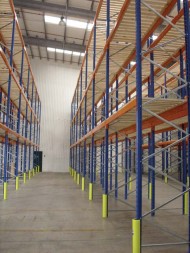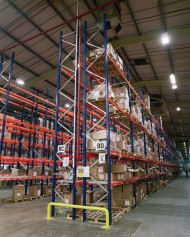 By Alex Ashcroft, Installation & Projects Manager, Constructor Group UK.
By Alex Ashcroft, Installation & Projects Manager, Constructor Group UK.
Around 10,000 work-related injuries were recorded in the warehousing, storage and road haulage sectors in 2005-06, according to figures from the Health and Safety Executive (HSE). It is a requirement of the HSE, as detailed in “Health & Safety in Wholesale and Retail Warehouses”, that racking and shelving storage systems must be installed, used and maintained correctly to protect against injuries. Similarly it is essential that warehouse staff work in a safe environment where equipment is regularly checked for damage and defects.
If a racking system collapses it can lead to major injury or even death. Racking is manufactured from relatively light components and consequently is susceptible to damage. Any damage to racking will reduce its loading capacity. Eventually the racking will collapse even when it is within specified safe load limits. Prevention is always better than the cure, and is less expensive. Periodic, rack safety audits make good business sense and are a critical component of every warehouse’s successful planning and operation.
In general terms, storage equipment comes in two categories, shelving and racking. Shelving is for pedestrian picking, hand-loaded applications and as such, under normal use, sustains little damage. Racking however is constantly being loaded and unloaded with mechanical handling equipment and therefore is much more susceptible to damage.
WHAT TO LOOK FOR:
The HSE and The Storage Equipment Manufacturers Association (S.E.M.A.) give the following areas to look at for potential problems. These are divided into two distinct areas, beams and uprights:
1. Beams:
a) Missing beam locks/pins
b) Bent/deformed beams when unloaded
c) Dislodged beam connectors
d) Damaged beam profiles.
2. Uprights:
a) Front impact damage (limit 5mm)
b) Side impact damage (limit 3mm)
c) Damaged/missing braces.
d) Damaged/missing floor fixings
The limits quoted are measured by using a simple 1m long straight edge held against the racking upright. The damage/deflection is then measured in the centre of the straight edge.
POTENTIAL CAUSES OF SHELVING & RACKING DAMAGE
 It is essential that companies use qualified forklift truck drivers who should only be expected to work within their capabilities. Not only is it necessary to use the right type of truck intended for a particular installation, it is also important to ensure that the layout of the racking system provides good access for that vehicle with adequate aisle widths free from obstruction.
It is essential that companies use qualified forklift truck drivers who should only be expected to work within their capabilities. Not only is it necessary to use the right type of truck intended for a particular installation, it is also important to ensure that the layout of the racking system provides good access for that vehicle with adequate aisle widths free from obstruction.
Pallets and decking can also be a potential cause of damage. Broken, or poor quality pallets can cause premature beam failure by putting outward pressure on the inside faces of the beams. Dropping heavy goods on to decking, overloading, or forcing items into place can cause them to weaken and become unstable. The decking being struck by access equipment, fork trucks and other heavy lifting equipment can cause other possible hazards.
Other rack accidents occur when the structures are not properly secured to the floor slab or when unsecured beams are dislodged. Improper loading, either by exceeding capacity constraints or not placing the pallet’s squarely on the decking can cause it to either tip off the front or back of the rack or to push another pallet off an adjacent rack in a double-deep situation. In addition, post palets provide a series of pointloads for which beams may not be designed.
PROTECTING RACKING
Collisions between forklifts and racking are a relatively common occurrence in a busy warehouse. Where racking is likely to be struck by vehicles it should be protected with column guards or rail systems. Semi-flexible, moulded plastic guards, such as the Sentry products, are quickly and easily attached to racking or building columns in seconds to form a protective bumper that minimises the force of fork truck collision that can damage racking frames, structural columns, vehicles and operators.
 These drastically reduce the power of fork truck impact that can easily damage the structural integrity of racks and floors leading to health & safety issues and expensive repairs. They are designed to fit all standard European racking uprights and are easily fitted around the feet of racking systems and secured by Velcro straps. These products deflect any impact energy away from the racking to provide effective protection against most collision damage.
These drastically reduce the power of fork truck impact that can easily damage the structural integrity of racks and floors leading to health & safety issues and expensive repairs. They are designed to fit all standard European racking uprights and are easily fitted around the feet of racking systems and secured by Velcro straps. These products deflect any impact energy away from the racking to provide effective protection against most collision damage.
In addition to upright protection, rack-end protection, guide rails and tunnel guards there is netting and wire mesh backing and safety signs, which include safe working load markings and maintenance signs. These are all critical items in racking safety.
MAINTENANCE CONTRACTS
When there is a high degree of activity in the warehouse, it is especially important that trained and competent rack safety personnel regularly inspect the racking system. When a forklift has struck a rack, one of the first priorities should be to identify any unsafe components in order to reduce the dangers of collapse. Specific precautions and taking damaged racking out of service immediately may be the only prudent response to prevent possible risk of injury to personnel caused by continued use of damaged racking. Rack safety is the employer’s moral responsibility and comes with substantial legal liabilities (civil and criminal).
An audit will assist in ensuring the number of incidents is kept to a minimum and it will examine the set up of the warehouse and help identify a pattern of operation that may be contributing to rack damage, or that additional training, signage, or upgraded rack protection systems are required. In addition a racking maintenance contract with a respected company, such as Dexion ensures compliance with health and safety regulations. The Workplace (Heath, Safety & Welfare) Regulations 1992, states: “The workplace and the equipment, devices and systems to which the regulation applies shall be maintained in an efficient state, in efficient working order and in good repair”.
The PUWER Regulations (Provision and Use of Work Equipment Regulations 1998) states that audit period should not exceed 12 months. Section 5 states “…equipment to be maintained in an efficient state, in efficient working order and in good repair” and that repairs, modifications, maintenance and servicing are restricted to competent personnel.
 The contracted company will arrange for trained technicians to make an initial site visit and inspection to provide a detailed assessment of the storage system and layout. Following the visit, a report will be sent to the customer highlighting any damaged, missing or badly fitted components and detailing any replacements and repairs that need to be carried out. Such contracts not only give peace of mind to the employer but also provide a written history for Health & Safety Inspectors and Insurance Companies. They allow for continuity and help ensure that storage systems are maintained in a safe and workable condition.
The contracted company will arrange for trained technicians to make an initial site visit and inspection to provide a detailed assessment of the storage system and layout. Following the visit, a report will be sent to the customer highlighting any damaged, missing or badly fitted components and detailing any replacements and repairs that need to be carried out. Such contracts not only give peace of mind to the employer but also provide a written history for Health & Safety Inspectors and Insurance Companies. They allow for continuity and help ensure that storage systems are maintained in a safe and workable condition.
Constructor Group UK Ltd Tel: 01793 694071 Email: sales@planned-storage.co.uk www.constructor-group.co.uk





Comments are closed.